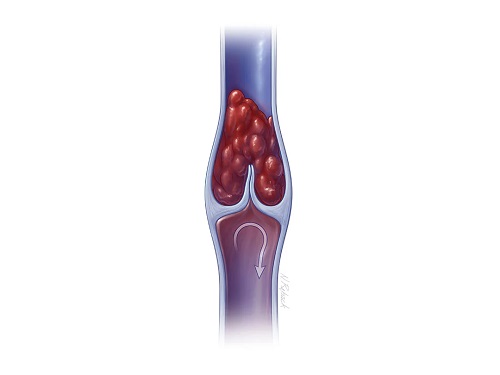
What is deep vein thrombosis?
Deep vein thrombosis (DVT) is a serious condition in which a blood clot forms in one or more of the deep veins.

The symptoms of a DVT can go unrecognised.
What causes DVT?
Deep vein thrombosis is usually caused by a combination of different underlying conditions:
Restricted movement
Blood flow in the veins is slowed down because of restricted movement for a long period of time (illness, after surgery, long-distance traveling).
Blood clots form more easily than normal
The risk of getting DVT is increased with a condition that causes blood to clot (coagulate) more easily than normal. Some of these conditions include:
- cancer and cancer treatments
- heart disease and lung disease
- thrombophilia, a genetic condition where the blood has an increased tendency to clot
Infections or inflammation
Infections or inflammation can promote thrombus formation by affecting the lining surface of the vein, e.g. through vessel wall damage and increased coagulability.
Damaged blood vessels
If the wall of a blood vessel is damaged, it may become narrowed or blocked, which can cause a blood clot to form. Blood vessels can be damaged by injuries such as broken bones or severe muscle damage.
Pregnancy
DVTs are rare in pregnancy, although pregnant women are 3 to 4 times more likely to develop thrombosis than non-pregnant women of the same age. A clot can form at any stage of pregnancy and up to six weeks after giving birth.
In addition, several risk factors for the development of DVT exist.
What are some potential complications of DVT?
About one of every two to three patients with previous DVT will develop a long-term complication known as post-thrombotic syndrome (PTS), despite optimal anticoagulant treatment. PTS is a progressive disease and it can show up as chronic pain, swelling, and discoloration of the leg and, in late stages, as open leg ulcers.
The likelihood of another clot forming is high once you have had aDVT event. The effects of PTS are long lasting and can lessen your quality of life substantially.
Another complication of DVT is a condition known as pulmonary embolism (PE) which occurs when a blood clot breaks loose and travels through the vessel to the lungs. A pulmonary embolism can be fatal if the blood clot significantly blocks blood flow through the lungs.
What are the symptoms of a DVT?
Nearly 50% of all DVT cases have no noticeable symptoms. If symptoms are present, they can include leg pain and tenderness, swelling in the calf muscle, ankle, foot, or thigh – usually in one leg only. At times, the skin feels warm and is reddened.

Am I at risk for developing a DVT?
Are you over 60? Are you traveling long distances, thereby sitting for prolonged time withrestricted mobility? Are you overweight and/or lead a sedentary lifestyle? If you answered yes to any of these questions, you may be at risk for developing DVT.
Other risk factors include:
- Surgery (especially orthopedic) or major injury
- Smoking
- Varicose veins
- High levels of estrogen, such as during pregnancy or when using birth control pills (hormonal contraception)
- Cancer
- Prolonged bed rest or immobility, e.g. during hospitalization
How is DVT diagnosed?
Diagnosis of DVT can be made quickly with a simple ultrasound scan that is painless and risk-free. A specific blood test may be performed to measure the level of “D-dimers” which is a sign of recent clotting. Early diagnosis and treatment greatly reduce your risk of serious complications.
There are other tests that your physician may recommend depending on your medical history.
“More than two million Americans are affected by blood clots every year.”
Did you know?
- 74% of adults have little to no awareness of DVT.
- A pregnant woman is 5 to 6 times more likely to develop a DVT than a non-pregnant woman.
- 40% of patients with an existing DVT will experience a further DVT within 1 to 2 years.
- Wearing compression stockings or socks reduces the risk to develop DVT and associated complications.
Summary
Deep vein thrombosis (DVT) is classified as an acute venous disorder.
Basic medical knowledge on venous disorders
- With the term Chronic Venous Disorder (CVD) we describe a long-standing condition involving impaired venous return.
- If vein valves don’t close properly, a reflux results: the blood leaks downwards and stagnates in the vein, thereby leading to venous hypertension. This condition is known as chronic venous insufficiency (CVI) which may cause edema, skin change, and, in some cases, ulcerations.
- If left untreated, chronic venous insufficiency can result in the formation of serious disorders, including phlebitis and pulmonary embolism. To distinguish the different manifestations of CVD, the CEAP classification system is used.
- Acute venous disorders usually occur without pre-existing conditions, but they can also be triggered by chronic venous disorders. In any case, medical treatment is immediately required. Acute venous disorders include superficial thrombophlebitis, deep vein thrombosis (DVT), pulmonary embolism, post-thrombotic syndrome, and variceal bleeding.
SOURCE: https://bit.ly/3tjoDKe
